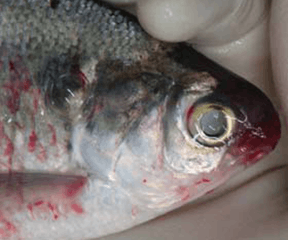Cyprinid herpesvirus 3
| Cyprinid herpesvirus 3 | |
|---|---|
| Virus classification | |
| Group: | Group I (dsDNA) |
| Order: | Herpesvirales |
| Family: | Alloherpesviridae |
| Genus: | Cyprinivirus |
| Species: | Cyprinid herpesvirus 3 |
| Synonyms | |
|
CyHV-3 | |
Cyprinid herpesvirus 3 (also CyHV-3, koi herpes virus, or KHV), is a species of virus causing a viral disease that is very contagious to the common carp Cyrpinus carpio. It is most commonly found in ornamental koi, which are often used in outdoor ponds or as feeder stock. The first case of KHV was reported in 1998, but not confirmed until later in 1999.
KHV is a DNA-based virus. After discovery, it was identified as a strain of herpesvirus. Like other strains, KHV stays with the infected fish for the duration of their lives, making the recovered and exposed fish potential carriers of the virus. Koi fish infected with KHV may die within the first 24-48 hours of exposure. The virus is found in 33 countries.[1]
KHV is listed as a nonexotic disease of the EU, so is watched closely by the European Community Reference Laboratory for Fish Diseases.
Symptoms of KHV include:
- Gill mottling
- Red and white patches appearing on gills
- Bleeding gills
- Sunken eyes
- Pale patches
- Blisters
In 2016 the Australian Government announced plans to release the virus into the Murray-Darling basin in an attempt to control carp populations in the water system.[2][3]
References
- ↑ Thistleton, John (13 June 2016). "Millions of Lake Burley Griffin carp face swift death from cyprinid herpesvirus release". The Canberra Times. Fairfax Media. Archived from the original on 13 June 2016.
- ↑ Cerny, David W. (1 May 2016). "Australia to spend over $11mn to eradicate carps by releasing herpes virus into rivers". Archived from the original on 2 June 2016.
- ↑ Kilvert, Nick; Thomas, Kerrin (1 May 2016). "Herpes virus to be used in fight against carp in Murray River, Christopher Pyne says". ABC News. Australian Broadcasting Corporation. Archived from the original on 5 May 2016.
External links
- Invading Species.com Ontario Ministry of Natural Resources and the Ontario Federation of Anglers and Hunters
- Koi Herpes Virus (KHV) Disease. Institute of Food and Agricultural Sciences Fact Sheet VM-149, University of Florida.
- K.H.V. Koi Herpes Virus. National Fish Pharmaceuticals
- European Community Reference Laboratory for Fish Diseases
